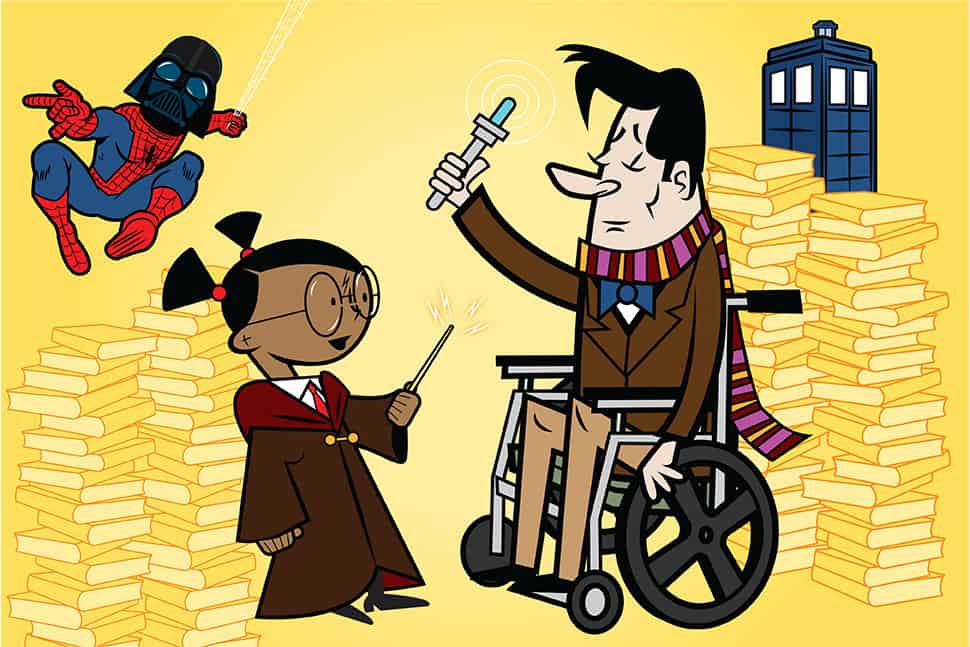
As a youth and teen services librarian at North Liberty (Iowa) Community Library, Andrew Frisbie was used to seeking creative ways to help shy adolescent patrons feel more comfortable. So when one of his teenage regulars, “Shelby” (not her real name), confessed that she loved writing fan fiction, he smiled and said, “Me too!”
That was the beginning of a big confidence boost on Shelby’s part, says Frisbie, who is now a collection development librarian at the same branch. The pair began collaborating on a story based on characters from the video-game series The Legend of Zelda, taking it in turns each week to continue and give feedback on the other person’s work.
“It made it much easier for her to engage with me and with the rest of our staff,” Frisbie says. “And she got more confident in her writing. She got a lot less apprehensive and a lot more excited about handing over what she had written.”
All of that during a stage of life when many patrons are more consumed with after-school jobs and burgeoning romantic relationships than with what’s going on at their local library.
Getting teens more comfortable engaging with the library and librarians, more enthusiastic about the power of words, and more confident in their own abilities—can fan fiction really do all this?
A quick history of fanfic

Fan fiction (often abbreviated “fanfic”) is fiction based on an existing work, such as a novel, television show, or movie. It may use the original work’s characters, setting, or both. It may create new relationships for characters, place characters in completely different settings, invent new characters, combine characters from different works, or all of the above. And it may change characters’ genders, ethnicities, sexual orientations, and physical or mental abilities.
“Depending on how widely you want to open up the definition, you can find evidence for fan fiction going back centuries,” says Nancy-Anne Davies, adult services librarian at the Lillian H. Smith district branch of the Toronto Public Library and one of the presenters of a fan fiction program at the 2015 Ontario Library Association Super Conference.
To give just a few examples: Shakespeare borrowed the characters and plot of Romeo and Juliet from a narrative poem, Arthur Brooke’s The Tragicall Historye of Romeus and Juliet, which in turn was based on a French translation of an Italian novella by Matteo Bandello.
Skipping a few centuries, in 1913, Englishwoman Sybil G. Brinton took characters from six Jane Austen novels and brought them into one new work of her own, Old Friends and New Fancies. (And here you thought the Jane Austen fanfic craze began in 2009 with Seth Grahame-Smith’s Pride and Prejudice and Zombies.)
Plenty of well-respected modern authors have used an existing work of literature as a jumping-off point for another one. Take Jean Rhys’s Wide Sargasso Sea, which, written as a prequel to Charlotte Brontë’s Jane Eyre, considers the life story of the “madwoman in the attic.” Or consider Tom Stoppard’s Rosencrantz and Guildenstern Are Dead, the absurdist play that takes two minor characters from Shakespeare’s Hamlet and sets them at the center of the action.
But the piece of fan fiction that’s grabbed the most attention recently is the 2011 erotic romance novel Fifty Shades of Grey. The trilogy’s author, E. L. James, originally wrote the book and its sequels as fan fiction of Stephenie Meyer’s Twilight series, then rewrote them and changed the characters’ names so that they could be published as original works.
“Here you had a published work of fan fiction widely available in libraries and that people were reading in book clubs,” Davies says. “There definitely was this really big shift in the mainstream attitude [toward fan fiction].”
Then, too, wildly popular young-adult author Cassandra Clare started out writing Harry Potter and Lord of the Rings fan fiction. Rainbow Rowell not only wrote an entire novel, 2013’s Fangirl, that centered on a first-year college student and her passion for fan fiction; she also followed it up in 2015 by writing a novel, Carry On, set in the world about which Fangirl’s protagonist writes fan fiction.
“And now we have [the play] Harry Potter and the Cursed Child, picking up the original Harry Potter characters years later, associated with the original author but not written by her,” points out Rebecca Honeycutt, who writes about new books for kids and teens in her role as NextReads bibliographer at NoveList, and who helped deliver a presentation about fan fiction to the North Carolina Library Association last year. “We live in such a remix culture now.”
Fanfic in the library
As with many cultural changes, teens have been riding the fan fiction wave long before the rest of us, reading and sharing it on sites such as Archive of Our Own, Wattpad, and Fanfiction.net, which have been around for many years (in the case of the latter, since 1998).
Though many librarians have long been familiar with the fan fiction phenomenon themselves, not until fairly recently have libraries started engaging patrons around it.
One of the primary things fanfic offers readers that mainstream literature often doesn’t is a broader array of characters. “Fan fiction does have a long way to go regarding diversity, but you can find a lot more there than in mainstream fiction,” Honeycutt says. “So when readers are disappointed in something for that reason, fanfic can be a great panacea.”
Davies agrees: “One of the things that lies at the heart of what makes fan fiction so dear to people is its ability to take characters and adapt them and claim spaces that they’ve previously been denied access to.”
She’s talking about the tendency of fanfic writers to change characters’ genders, races, and whatever else they please—or to simply interpret a character’s existing traits in a particular way. In fan fiction, Sherlock Holmes doesn’t have to be merely aloof or antisocial; he can be on the autism spectrum, asexual, aromantic, all or none of the above, or something else entirely. “So the diversity impact is huge,” Davies says.
The ability of fan fiction to console those who don’t see themselves reflected in the works they love is especially evident in the experience of fans of Teen Wolf, a show that began airing on MTV in 2011.
At first, there was talk from the show’s creators that one of its characters, Stiles, would eventually be revealed as bisexual—“which, for the part of the fandom that identifies that way, would have been huge,” Davies says. “But the show never followed through on it, and a lot of people are still really angry about it, because they want that representation. So even though it wasn’t given to them, they’re still very adamant about claiming it for themselves.” Fan fiction lets them do that.
Another reason for libraries to educate themselves about fan fiction, in Honeycutt’s view: They have much to learn from the way that fan fiction readers search for what they read.
“Fan fiction sites have these great tagging systems that are often very wonderful and searchable in ways that libraries can’t always use, because they have these standardized taxonomies,” she says.
“But your readers’ advisory doesn’t have to be as hidebound as your catalog, so you can see what tropes people are into, what tags are popular, and that can organize how you recommend books to people. Fanfic readers are so used to being able to search for what they want and what they don’t want. And paying attention to that can help librarians see how people read and how they want to find what they want to read.”
And then there’s the way in which simply being in the know about fan fiction can help a librarian draw in shy or disengaged patrons.
“They always like it when the librarian is as geeky and knowledgeable about different fandoms as they are,” says Jennifer Finch, who regularly chats up teens about fan fiction in her role as young adult services librarian at the Katherine Tyra branch of the Harris County Public Library in Houston. “It makes the library a little bit more of a fun place for them to be.”
Getting a fanfic group going
Libraries that have a thriving young-adult population—or that would like to grow one—might consider starting a monthly fan fiction group, in which participants share feedback on each other’s works in a supportive setting.
Davies started hers in early 2014, when she was working as a youth librarian. “I started to notice that the kids I was working with in our youth advisory group talked about fan fiction in an open way. That, for me, was kind of the light-bulb moment,” she says.
“I asked them, ‘How would you feel about having a group where yourselves or other teens dedicated to fanfic could come once or twice a month to sit down and chew the fat about stuff you’re writing or reading in a library setting?’ They were really, really enthusiastic about it,” Davies says. So enthusiastic, in fact, that the Tumblr post she made to advertise the group received close to 1,500 likes. “We had librarians from all over the world contact us, saying, ‘Hey, we’d love to do this at our branch. What’s your advice?’” she remembers.
Around 30 kids from all over the city participated in the first meeting, Davies says. “That number petered out a little bit over time—we met once a month—but we had a core group of between 10 and 15 kids. Since it was a drop-in type of program, we’d often get some new faces showing up, too,” she adds.
Now that Davies has switched branches and positions, the teen group has vanished and a similar group for adults has taken its place.
“It’s even more successful in some ways, because there’s more self-motivation, and there’s more of a long-term commitment,” she says. The members of the 22-person group share their work from week to week through a private Google Group. Between meetings, everyone is responsible for reading what others have posted.
“Groups like these, that bridge people’s online lives and their real lives, have the capacity to reach out to a library’s invisible customer base,” she continues. “For people who may have only interacted with the library online or may have not been involved with the library before, this is an impetus for them to get more involved.”
One concern librarians may have when starting a fan fiction group for teens, especially teens of widely varying ages, is how to make sure the work shared in the group doesn’t veer into NC-17 territory.
While it’s an unfortunate myth that all fan fiction contains graphic descriptions of sexual activity, some of it does. And while facilitators can’t control what participants access at home, they should set firm ground rules for what will and won’t be considered acceptable in the group.
“I out-and-out explain that the fan fiction websites have rating systems for a reason,” says Finch, who leads fan fiction writing workshops for teens each summer. “I tell them that the writing they do in the workshop should be of the same type that they could turn into their teachers at school without getting into trouble. Usually, if you do it right, they just laugh.”
Librarians may also worry about copyright issues. After all, most teenagers who create fan fiction are more interested in writing about current popular characters, rather than those from works in the public domain, such as Hamlet or Pride and Prejudice. However, as long as fan fiction writers aren’t making a profit from their creations, most creators are fine with it—or even delighted. No less a personage than Harry Potter series author J. K. Rowling has said: “I find it very flattering that people love the characters that much.”
The Organization for Transformative Works, a nonprofit group that provides access to and preserves the history of fan works and fan cultures, states that fan fiction is considered fair use under current copyright law. (That said, some authors, such as George R. R. Martin and Laurell K. Hamilton, have explicitly discouraged fan fiction about their works. A list of these authors is available at fanlore.org.)
Libraries that don’t have the staffing or other resources to handle an ongoing writing group might consider having a fan fiction writing contest instead, as librarian John Hilbert has done each year for the past several years at Southern Oaks Library in Oklahoma City.
“I’ll get anywhere from 15 to 35 pieces of writing, and the local stores donate prizes,” he says. “And I’ll get the judges to give critiques of the writing, because that’s what a lot of the young people want; they love the input. They’re really happy that they’re getting some kind of recognition for their work.”
Like Finch and Frisbie, he’s found that fan fiction is its own form of patron outreach. “These tend to be young people who would not normally get involved in the library,” he says. “They may hang out here, but they’re not kids who would generally go to programs.”
If you or your library aren’t ready to launch a full-out fan fiction group or contest just yet, know that being even just a bit more knowledgeable about this thriving area can help you connect with readers.
“From a reader advisory perspective, just knowing about what is happening in fanfic culture keeps you current and allows you to make more passionate connections with your patrons,” Honeycutt says. “They’ll remember you forever as the librarian who understood what they were talking about.”

 ANNE FORD is a writer based in Evanston, Illinois, and editor-at-large for American Libraries.
ANNE FORD is a writer based in Evanston, Illinois, and editor-at-large for American Libraries.
